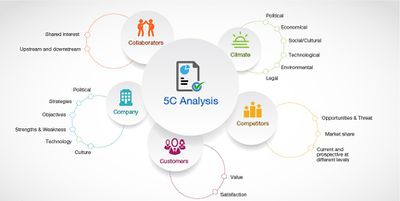5C's of Marketing Strategy
A useful framework for performing a situation analysis is the 5C Analysis. The 5C Analysis is an environmental scan on five key area especially applicable to marketing decisions. It covers the internal, micro-environmental, and the macro-environmental situation. The 5 C analysis is an extension of the 3C analysis (company, customers, and competitors), to which some marketers added the 4th C of collaborators. The further addition of a macro-environmental analysis (climate or context) results in a 5C analysis. [1]
- Company
When analyzing a company using the 5C marketing framework, the key issue is to identify the Sustainable Competitive Advantage that belongs to the focal company. It can be in the form of brand equity, economies of scale, technological development, etc. To identify if the assets belonging to the focal company is a sustainable competitive advantage, the VRIO (Variable Rare Imitable Organized) model can be utilized to distinguish if a company’s assets offer a temporary or sustainable advantage to the overall business model.
- Collaborators
Collaborators are entities that allow or enhance a company to provide its particular good or service in the way that it does. It primarily revolves around a company’s supply chain that ranges from spot contracts up to quasi-vertical integration. The direction of integration can only be upstream as downstream collaborators are more specifically defined as customers in the 5C Analysis framework.
- Customers
The group of potential customers a company can reach with its products or services can be broken down into three main sizes: Total Available Market, Serviceable Available Market, and Target Market. The market segments may be further segmented through demographics, psychographics, geography and other distinguishing factors. The Total Available Market (TAM) is the most generalized customer segment that includes every possible customer that demands a particular product or service. The Serviceable Available Market (SAM) would be a subset of the TAM that is categorized by potential use of a company’s product or service. The Serviceable Obtainable Market (SOM) sub-segment of the market is the narrowest definition that specifies the segment of a market a company would realistically aim to capture.
- Competitors
Competition can be found in the form of other companies operating in the same industry as the focal company. To determine the industry, industry classification systems such as the North American Industry Classification System exists to provide a standardized method of defining an industry. One common metric to identify players of interest is to examine the market share within the industry. It is typically stated through the concentration ratio CR4, which shows the percentage of market share held by the four largest firms in the industry. Note, however, that industry classification systems may not provide a sufficiently thorough industry definition for certain companies. It can occur because a firm may adopt a pure play approach, i.e. operates across multiple industries or it may serve a niche market that differs from the traditional industry definition.
- Context
The context in which a business operates is most often analyzed with the use of PESTLE analysis. It provides coverage into the areas that may affect a business but where the business exercises either no or limited control over. Changes to contextual factors may impact the industry as a whole rather than a particular company. As such, an advantage experienced by such changes may not translate into a competitive advantage for the focal company or vice versa.[2]

Source: SM Study
References
Further Reading
- Consider 5Cs--Customers, Collaborators, Capabilities, Competitors, Conditions--In Onboarding Prep Forbes
- The Five Cs of Opportunity Identification HBR
See Also
Marketing
Marketing Effectiveness
Marketing Metrics
Marketing Mix 4P's 5P's
Marketing Operations Management (MOM)
Marketing Plan
Marketing Resource Management (MRM)
Marketing Strategy
IT Strategic Planning
e-Business Strategic Planning
Governance of Information Technology (ICT)
What is Enterprise Architecture Planning
Information Technology Sourcing (IT Sourcing)
Information Technology Operations (IT Operations)
Chief Information Officer (CIO)
Leadership
